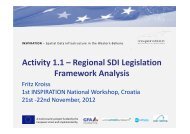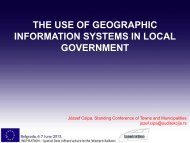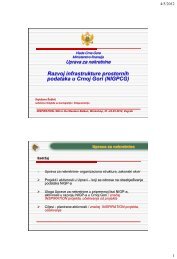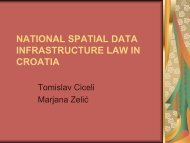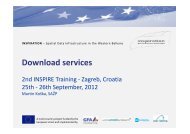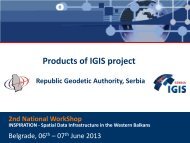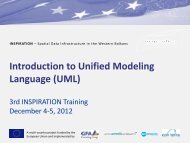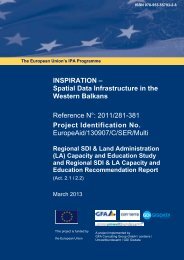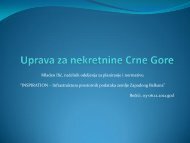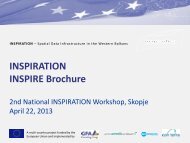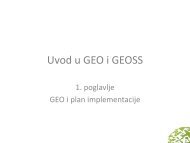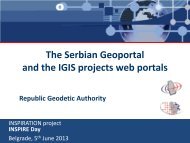MOVE - Moderation and Visualization for Group ... - INSPIRATION
MOVE - Moderation and Visualization for Group ... - INSPIRATION
MOVE - Moderation and Visualization for Group ... - INSPIRATION
You also want an ePaper? Increase the reach of your titles
YUMPU automatically turns print PDFs into web optimized ePapers that Google loves.
For example, it is one thing to dig into lengthy<br />
explanations about complex <strong>and</strong> complicated<br />
concepts such as Geographical In<strong>for</strong>mation<br />
System (GIS), <strong>and</strong> it is another to visualize<br />
crucial aspects of such a concept by means of<br />
photos <strong>and</strong> other graphical support such as the<br />
illustration to the right.<br />
All of the sudden, people <strong>and</strong> their creative <strong>and</strong><br />
intellectual potentials were at the center of<br />
attention, not predetermined institutional<br />
positions or bits of ‘eternal’ scientific knowledge,<br />
or technical know-how. Plenary sessions were<br />
often broken down into small working group<br />
interaction, <strong>and</strong> the monologue by lecturers <strong>and</strong><br />
dominant trainers was replaced by dialogue<br />
between participants, trainers <strong>and</strong> moderators.<br />
Most of them left a course with a sense of having<br />
learned something new <strong>and</strong> valuable <strong>for</strong> themselves<br />
<strong>and</strong> their work. As a result, the moderation<br />
method sufficiently convinced DSE, <strong>and</strong> the<br />
organization made its adult education philosophy<br />
the backbone of its overall didactical concept<br />
in the mid 1990s. Courses <strong>for</strong> moderators <strong>and</strong><br />
trainers on what then was called ‘Participatory<br />
Approaches <strong>for</strong> Cooperative <strong>Group</strong> Events’ (see<br />
Ullrich et al 1991) were offered in English,<br />
French <strong>and</strong> Spanish since the mid 1980s.<br />
The success story of the ‘<strong>Moderation</strong> Method’<br />
resembles the situation described in the<br />
Prologue’s right-h<strong>and</strong> column. Those who<br />
Why a <strong>MOVE</strong> Manual?<br />
Over the last 20 years, InWEnt, respectively, DSE<br />
<strong>and</strong> CDG, have garnered positive experiences<br />
with improving group interaction in international<br />
training through moderation <strong>and</strong> visualization<br />
methods. Many trainees who participated<br />
in related courses later became moderators <strong>and</strong><br />
trainers themselves or applied the newly-gained<br />
methods in their own working environments. To<br />
their assistance, some internal manuals on the<br />
methods were published by DSE (e.g., Participatory<br />
Approaches 1986) <strong>and</strong> by moderators <strong>and</strong><br />
institutions that adopted them (e.g., VIPP 1993).<br />
In the 1990s, when international training<br />
became even more integrated with human<br />
11<br />
attended an InWEnt training event will know the<br />
difference. What strikes the attention first is the<br />
‘hardware’ – the boards <strong>and</strong> cards etc. – which<br />
differ from the conventional classroom setup.<br />
But what is really different, is the ‘software’, the<br />
philosophy <strong>and</strong> ethics of the method, especially<br />
its belief in the creative <strong>and</strong> intellectual potential<br />
of every person concerned. The approach<br />
involves all participants in the working process of<br />
arriving at a consensus, not just a few ‘loud<br />
mouths’ who often dominate a meeting. Full<br />
participation leads to higher individual creativity<br />
<strong>and</strong> activates the assembled pool of knowledge<br />
<strong>and</strong> experiences. The result of such a working<br />
process is best summarized in a motto that is<br />
often heard in moderated events: “Nobody knows<br />
everything – everybody knows something”.<br />
resource development <strong>and</strong> institutional capacity<br />
building, e.g., in the context of long-term<br />
environmental management programs of DSE-<br />
ZÖV (Public Administration Promotion Center)<br />
in Viet Nam <strong>and</strong> Indonesia, the need <strong>for</strong> a more<br />
defined body of know-how became evident.<br />
There<strong>for</strong>e, the idea emerged to share <strong>and</strong><br />
synthesize its lessons learned under a new name<br />
– <strong>MOVE</strong>, <strong>Moderation</strong> <strong>and</strong> <strong>Visualization</strong> <strong>for</strong><br />
<strong>Group</strong> Events – <strong>and</strong> to make these lessons<br />
available in a manual.<br />
The publication provides a brief introduction to<br />
the essential elements of the approach, <strong>and</strong> it



